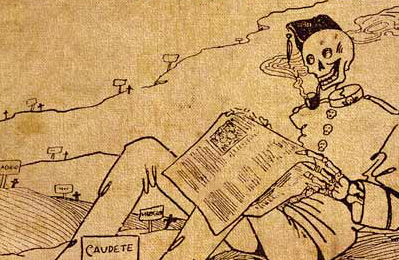AIDS. The Black Plague. Ebola. The flu?
When people hear the word “flu,” it may not strike fear in their hearts. Yet influenza was the cause of one of the most devastating epidemics in human history.
“No one quakes in their boots when they hear the word flu,” said Assistant Professor of Spanish Ryan Davis, “but we are talking about a disease that may have killed as many as 100 million people between 1918 and 1919.”
Davis is the author of The Spanish Flu: Narrative and Cultural Identity in Spain, 1918. He studies not just the flu that raced across the globe, but how the people of Spain reacted to the epidemic on a cultural level. He is also a co-editor of and contributor to The Spanish Influenza Pandemic 1918-1919, which will be published in a few weeks.
According to Davis, although theories of where the epidemic originated vary, the Spanish Flu didn’t begin in Spain. Though it did receive a lot of press coverage there. “You have to remember that this was happening during World War I. Countries such as Germany and France did not want the health and state of their troops known to the enemy,” said Davis. “Spain was not part of the first World War. So while their coverage was mainly focused on the Great War, they also talked about this illness.”
While the outside world took to calling the epidemic the Spanish Flu, people of Spain called it something very different. “It was called ‘The Naples Soldier,’ at least that was the name that stuck,” said Davis, who noted The Naples Solider was a song in a smash operetta in early 1918. When the illness began to take hold, one of the composers joked the song was “as catchy as the flu, though less deadly.”

Assistant Professor Ryan Davis
Davis found the comparison of the flu virus to The Naples Soldier a culturally apt one for Spain. “The character of the Naples solider was a Don Juan figure, which represented so much socially and culturally in Spain at the time,” he said, noting Don Juan embodied the social order as a nobleman, yet also flouted the social order with his sexual exploits and duels. “In other words he was both familiar – and supposedly harmless – yet threatening at the same time. Spaniards saw the Spanish Flu the same way, so the metaphor of the Naples soldier stuck because it provided them a culturally familiar narrative framework with which to make sense of an otherwise bewildering experience.”
The Spanish Flu came in three waves – May to June of 1918, September to December of 1918 and January to June of 1919. During the first wave, scientists tried to isolate the pathogen that caused the epidemic the way they had with anthrax and cholera. “There was a feeling that if they could just isolate the right microbe, they would be able to create a vaccine,” said Davis, who has been studying the cultural impact of the Spanish Flu since his graduate days at Emory University.
When the second – and most deadly – wave of the flu hit, it shocked many people. “It was a huge blow to what one scholar called ‘scientific triumphalism’,” said Davis. “The flu poked a hole in the explanatory framework science had established, in the same way the Don Juan character jabbed at Spanish society and the fundamental core of Spanish identity.”
Davis studies literary texts and visual images that represented the evolution of the epidemic. Though a cure was not found – nor has been found to this day – the Spanish Flu was winding down by mid-1919. The last image he found depicting the epidemic was one of a doctor standing over the skeleton of the Naples soldier. “The doctor stands triumphant over the illness. Order was being restored,” said Davis.

